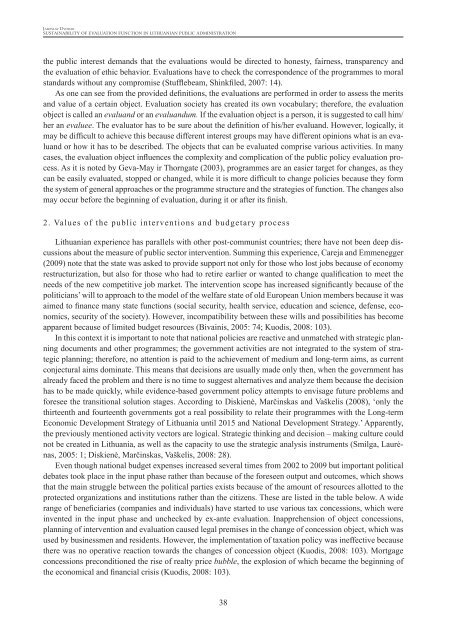Regional Formation 2012,1 - KlaipÄdos universitetas
Regional Formation 2012,1 - KlaipÄdos universitetas
Regional Formation 2012,1 - KlaipÄdos universitetas
You also want an ePaper? Increase the reach of your titles
YUMPU automatically turns print PDFs into web optimized ePapers that Google loves.
Jaroslav Dvorak<br />
SUSTAINABILITY OF EVALUATION FUNCTION IN LITHUANIAN PUBLIC ADMINISTRATION<br />
the public interest demands that the evaluations would be directed to honesty, fairness, transparency and<br />
the evaluation of ethic behavior. Evaluations have to check the correspondence of the programmes to moral<br />
standards without any compromise (Stufflebeam, Shinkfiled, 2007: 14).<br />
As one can see from the provided definitions, the evaluations are performed in order to assess the merits<br />
and value of a certain object. Evaluation society has created its own vocabulary; therefore, the evaluation<br />
object is called an evaluand or an evaluandum. If the evaluation object is a person, it is suggested to call him/<br />
her an evaluee. The evaluator has to be sure about the definition of his/her evaluand. However, logically, it<br />
may be difficult to achieve this because different interest groups may have different opinions what is an evaluand<br />
or how it has to be described. The objects that can be evaluated comprise various activities. In many<br />
cases, the evaluation object influences the complexity and complication of the public policy evaluation process.<br />
As it is noted by Geva-May ir Thorngate (2003), programmes are an easier target for changes, as they<br />
can be easily evaluated, stopped or changed, while it is more difficult to change policies because they form<br />
the system of general approaches or the programme structure and the strategies of function. The changes also<br />
may occur before the beginning of evaluation, during it or after its finish.<br />
2. Values of the public interventions and budgetary process<br />
Lithuanian experience has parallels with other post-communist countries; there have not been deep discussions<br />
about the measure of public sector intervention. Summing this experience, Careja and Emmenegger<br />
(2009) note that the state was asked to provide support not only for those who lost jobs because of economy<br />
restructurization, but also for those who had to retire earlier or wanted to change qualification to meet the<br />
needs of the new competitive job market. The intervention scope has increased significantly because of the<br />
politicians’ will to approach to the model of the welfare state of old European Union members because it was<br />
aimed to finance many state functions (social security, health service, education and science, defense, economics,<br />
security of the society). However, incompatibility between these wills and possibilities has become<br />
apparent because of limited budget resources (Bivainis, 2005: 74; Kuodis, 2008: 103).<br />
In this context it is important to note that national policies are reactive and unmatched with strategic planning<br />
documents and other programmes; the government activities are not integrated to the system of strategic<br />
planning; therefore, no attention is paid to the achievement of medium and long-term aims, as current<br />
conjectural aims dominate. This means that decisions are usually made only then, when the government has<br />
already faced the problem and there is no time to suggest alternatives and analyze them because the decision<br />
has to be made quickly, while evidence-based government policy attempts to envisage future problems and<br />
foresee the transitional solution stages. According to Diskienė, Marčinskas and Vaškelis (2008), ‘only the<br />
thirteenth and fourteenth governments got a real possibility to relate their programmes with the Long-term<br />
Economic Development Strategy of Lithuania until 2015 and National Development Strategy.’ Apparently,<br />
the previously mentioned activity vectors are logical. Strategic thinking and decision – making culture could<br />
not be created in Lithuania, as well as the capacity to use the strategic analysis instruments (Smilga, Laurėnas,<br />
2005: 1; Diskienė, Marčinskas, Vaškelis, 2008: 28).<br />
Even though national budget expenses increased several times from 2002 to 2009 but important political<br />
debates took place in the input phase rather than because of the foreseen output and outcomes, which shows<br />
that the main struggle between the political parties exists because of the amount of resources allotted to the<br />
protected organizations and institutions rather than the citizens. These are listed in the table below. A wide<br />
range of beneficiaries (companies and individuals) have started to use various tax concessions, which were<br />
invented in the input phase and unchecked by ex-ante evaluation. Inapprehension of object concessions,<br />
planning of intervention and evaluation caused legal premises in the change of concession object, which was<br />
used by businessmen and residents. However, the implementation of taxation policy was ineffective because<br />
there was no operative reaction towards the changes of concession object (Kuodis, 2008: 103). Mortgage<br />
concessions preconditioned the rise of realty price bubble, the explosion of which became the beginning of<br />
the economical and financial crisis (Kuodis, 2008: 103).<br />
38
















